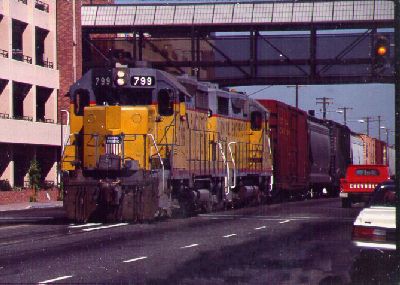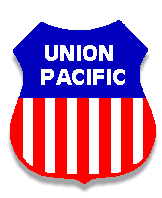|
|||
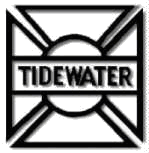
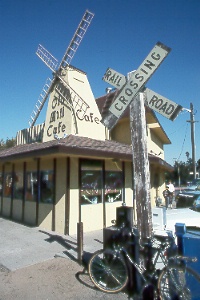
(Ken Rattenne photo)
|
Modesto, California:
1990
It's a warm, bright summer Saturday morning as we drive north along Ninth Street in Modesto's downtown district. The temperature has already reached 87 degrees at 10:30 in the morning, a sure sign that we're in for another Century mark day. As we make our way through the gauntlet of poky cars and traffic lights we constantly peer down the street, apprehensive that our quarry will appear before we're in place for our shot. The object of today's hunt is Union Pacific's local freight train that runs six days a week between Stockton and Modesto. The photograph we're after is one of the train rolling down the middle of Ninth Street, performing it's little dance with traffic for 1.1 miles of street running. As we approach the Old Mill Cafe we quickly turn left across track and traffic, pulling into a parking lot across the street from the quaint eatery. We grab our cameras and focus on the rails that curve around the north side of the cafe building. From here to D Street the rails are embedded in the pavement like street car tracks, marking the start of Modesto's infamous "street running1." Suddenly, the morning air is broken by the intruding blast of air horns. We we're just in time! A moment later we see the nose of the lead locomotive poke around cafe's corner, its headlights on full bright. Like a pair of cautious cats, Union Pacific GP35s 798 and 793 pause just long enough for the engineer and fireman to gauge the amount of traffic on the street. Then, with a wary eye and little to-do, the engineer of train LLF53 slowly notches his throttle forward. Puffs of grey-white exhaust shoot above the locomotives as 5,000 horses pull on 4,100 tons of train. As the train creeps slowly onto Ninth Street automobile traffic begins
scurrying to get out of the way. We press the shutter on our motor
drive as traffic begins scattering in ernest to make room for the lumbering
intruder. We quickly get in our car and race the locomotives down to the
Arch, an archaic steel lattice structure at the corner of Ninth and I streets
that proclaims MODESTO, WATER WEALTH CONTENTMENT HEALTH.
When the brace of units rumble by we press the shutter, framing the diesels
with this Modesto landmark.
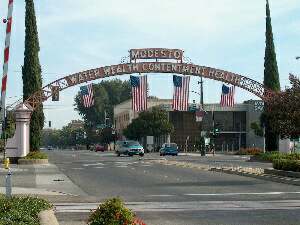 We've just witnessed another "Tidewater Job", part of the latest incarnation of the Tidewater Southern, a former interurban line and legacy of the late, great Western Pacific Railroad, now owned and operated by the Union Pacific.. TIn 1998 the line is just another part of the vast Union Pacific empire, referred to in company timetables as the Tidewater Subdivision of the Feather River Division. Though considered a branch line by UP, the railroad remains intact from its days as a Western Pacific subsidiary. It also remains profitable, with trains rolling almost daily between Stockton, Modesto and Turlock. But change is in the wind for the Tidewater, and as this is written much of that change has already taken place.
1. "Street running" refers to the practice of mainline trains mixing it up with vehicular traffic. Once a common practice in cities and towns across the country, today only a few pockets of such trackage still exists, most of it industrial trackage in large cities. |
||
